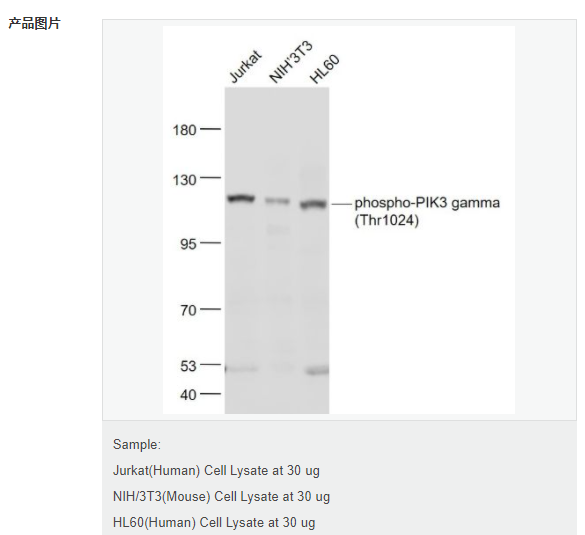

货号
产品规格
售价
备注
BN40241R-100ul
100ul
¥2220.00
交叉反应(总):Human,Mouse,Rat,Chicken,Dog,Pig,Cow,Horse,Rabbit,Sheep,;推荐应用:WB,
产品描述
| 英文名称 | phospho-PIK3 gamma (Thr1024) |
| 中文名称 | 磷酸化磷脂酰肌醇激酶PIK3-γ抗体 |
| 别 名 | PK3CG_HUMAN; Phosphatidylinositol 4,5-bisphosphate 3-kinase catalytic subunit gamma isoform; PI3-kinase subunit gamma; PI3K-gamma; PI3Kgamma; PtdIns-3-kinase subunit gamma; Phosphatidylinositol 4,5-bisphosphate 3-kinase 110 kDa catalytic subunit gamma; PtdIns-3-kinase subunit p110-gamma; p110gamma; Phosphoinositide-3-kinase catalytic gamma polypeptide; Serine/threonine protein kinase PIK3CG; 1 phosphatidylinositol 3 kinase; p120-PI3K; p120 PI3K; 5-bisphosphate 3-kinase 110 kDa catalytic subunit gamma; 5-bisphosphate 3-kinase catalytic subunit gamma isoform; p110 gamma; Phosphatidylinositol 3 kinase catalytic 110 kD gamma; Phosphatidylinositol 3 kinase gamma, p110 gamma; Phosphatidylinositol 3 kinase, catalytic, gamma polypeptide; Phosphatidylinositol 4 5 bisphosphate 3 kinase 110 kDa catalytic subunit gamma; Phosphatidylinositol 4 5 bisphosphate 3 kinase catalytic subunit gamma; Phosphatidylinositol 4 5 bisphosphate 3 kinase catalytic subunit gamma isoform; Phosphatidylinositol-4; Phosphoinositide 3 kinase catalytic gamma polypeptide; Phosphoinositide 3 kinase gamma catalytic subunit; PI3-kinase subunit gamma; PI3CG; PI3K; PIK3; Pik3cg; PtdIns-3-kinase subunit gamma; PtdIns-3-kinase subunit p110-gamma; Serine/threonine protein kinase PIK3CG. |
| 产品类型 | 磷酸化抗体 |
| 研究领域 | 肿瘤 免疫学 信号转导 激酶和磷酸酶 G蛋白偶联受体 G蛋白信号 |
| 抗体来源 | Rabbit |
| 克隆类型 | Polyclonal |
| 交叉反应 | Human, Mouse, (predicted: Rat, Chicken, Dog, Pig, Cow, Horse, Rabbit, Sheep, ) |
| 产品应用 | WB=1:500-2000 ELISA=1:5000-10000 IHC-P=1:100-500 IHC-F=1:100-500 ICC=1:100-500 IF=1:100-500 (石蜡切片需做抗原修复) not yet tested in other applications. optimal dilutions/concentrations should be determined by the end user. |
| 分 子 量 | 121kDa |
| 细胞定位 | 细胞浆 细胞膜 |
| 性 状 | Liquid |
| 浓 度 | 1mg/ml |
| 免 疫 原 | KLH conjugated synthesised phosphopeptide derived from human PIK3 gamma around the phosphorylation site of Thr1024:HH(p-T)NL |
| 亚 型 | IgG |
| 纯化方法 | affinity purified by Protein A |
| 储 存 液 | 0.01M TBS(pH7.4) with 1% BSA, 0.03% Proclin300 and 50% Glycerol. |
| 保存条件 | Shipped at 4℃. Store at -20 °C for one year. Avoid repeated freeze/thaw cycles. |
| PubMed | |
| 产品介绍 | This gene encodes a protein that belongs to the pi3/pi4-kinase family of proteins. The gene product is an enzyme that phosphorylates phosphoinositides on the 3-hydroxyl group of the inositol ring. It is an important modulator of extracellular signals, including those elicited by E-cadherin-mediated cell-cell adhesion, which plays an important role in maintenance of the structural and functional integrity of epithelia. In addition to its role in promoting assembly of adherens junctions, the protein is thought to play a pivotal role in the regulation of cytotoxicity in NK cells. The gene is located in a commonly deleted segment of chromosome 7 previously identified in myeloid leukemias. [provided by RefSeq, Jul 2008]. Function: Phosphoinositide-3-kinase (PI3K) that phosphorylates PtdIns(4,5)P2 (Phosphatidylinositol 4,5-bisphosphate) to generate phosphatidylinositol 3,4,5-trisphosphate (PIP3). PIP3 plays a key role by recruiting PH domain-containing proteins to the membrane, including AKT1 and PDPK1, activating signaling cascades involved in cell growth, survival, proliferation, motility and morphology. Links G-protein coupled receptor activation to PIP3 production. Involved in immune, inflammatory and allergic responses. Modulates leukocyte chemotaxis to inflammatory sites and in response to chemoattractant agents. May control leukocyte polarization and migration by regulating the spatial accumulation of PIP3 and by regulating the organization of F-actin formation and integrin-based adhesion at the leading edge. Controls motility of dendritic cells. Together with PIK3CD is involved in natural killer (NK) cell development and migration towards the sites of inflammation. Participates in T-lymphocyte migration. Regulates T-lymphocyte proliferation and cytokine production. Together with PIK3CD participates in T-lymphocyte development. Required for B-lymphocyte development and signaling. Together with PIK3CD participates in neutrophil respiratory burst. Together with PIK3CD is involved in neutrophil chemotaxis and extravasation. Together with PIK3CB promotes platelet aggregation and thrombosis. Regulates alpha-IIb/beta-3 integrins (ITGA2B/ ITGB3) adhesive function in platelets downstream of P2Y12 through a lipid kinase activity-independent mechanism. May have also a lipid kinase activity-dependent function in platelet aggregation. Involved in endothelial progenitor cell migration. Negative regulator of cardiac contractility. Modulates cardiac contractility by anchoring protein kinase A (PKA) and PDE3B activation, reducing cAMP levels. Regulates cardiac contractility also by promoting beta-adrenergic receptor internalization by binding to ADRBK1 and by non-muscle tropomyosin phosphorylation. Also has serine/threonine protein kinase activity: both lipid and protein kinase activities are required for beta-adrenergic receptor endocytosis. May also have a scaffolding role in modulating cardiac contractility. Contributes to cardiac hypertrophy under pathological stress. Through simultaneous binding of PDE3B to RAPGEF3 and PIK3R6 is assembled in a signaling complex in which the PI3K gamma complex is activated by RAPGEF3 and which is involved in angiogenesis. Subunit: Heterodimer of a catalytic subunit PIK3CG and a PIK3R5 or PIK3R6 regulatory subunit. Interacts with ADRBK1 through the PIK helical domain. Interaction with ADRBK1 is required for targeting to agonist-occupied receptor. Interacts with PDE3B. Interacts with TPM2. Interacts with EPHA8; regulates integrin-mediated cell adhesion to substrate. Interacts with HRAS1; the interaction is required for membrane recruitment and beta-gamma G protein dimer-dependent activation of the PI3K gamma complex PIK3CG:PIK3R6 (By similarity). Subcellular Location: Cytoplasm. Cell membrane. Tissue Specificity: Pancreas, skeletal muscle, liver and heart. Similarity: Belongs to the PI3/PI4-kinase family. Contains 1 C2 PI3K-type domain. Contains 1 PI3K-ABD domain. Contains 1 PI3K-RBD domain. Contains 1 PI3K/PI4K domain. Contains 1 PIK helical domain. SWISS: P48736 Gene ID: 5294 Database links: Human Human Human Human Human Important Note: This product as supplied is intended for research use only, not for use in human, therapeutic or diagnostic applications |
